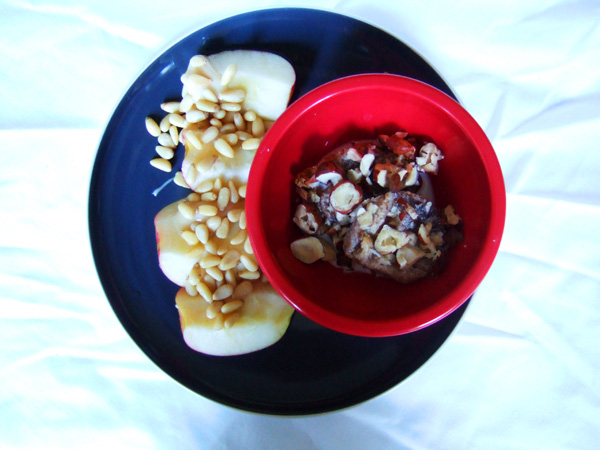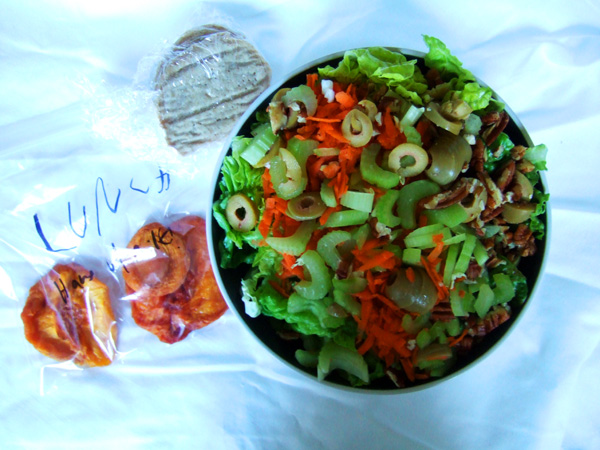Breakfast
Apples; Protoid Nuts; Filberts; Turkish pulled figs with cream +Raw Honey
I sliced my apple and smeared it with raw honey, then sprinkled the pine nuts over top. The filberts–hazelnuts–I added to the figs and cream.
I would normally have a cup of tea with my breakfast, and two to three more throughout the day. But Uncooked Foods advises against it:
It is impossible to keep alive the appetite for such stimulants as tobacco, fermented and distilled liquors, tea and coffee when the body is correctly fed. A being who subsists upon clean elementary foods would have no more desire for stimulants and narcotics than a horse or a dog would have for a Manhattan cocktail.
In the end, it will be nice to break my caffeine habit. But currently, I’m experiencing bouts of extreme drowsiness and headaches.
Lunch
Pecans; Olives; Vegetable Salad with Hygeia dressing; Unfired Crackers; Sweet Butter; Evaporated Peaches and raisins; Milk
I made most of my ingredients into a big salad, and packed the whole thing up for lunch. The biscuits I’m eating are miserable little things:
Bread forms a very important part of the uncooked menu, but its production is not practical in the home, where this book is intended to be of greatest use, as it requires special machinery for flaking and grinding the different grains and nuts of which it is made. It also requires a special electric light oven for drying during the winter when the rays of the sun cannot be utilized.
To meet conditions that exist, we make an exception here and give two recipes for bread that requires cooking, but is unfermented.
I haven’t quite figured out why the book dislikes fermentation. The recipe that they give for “unleavened gems” is 3 cups whole wheat flour to 2 cups cold water and 2 tablespoons of fat. Then “Take up on a spoon and work all the air possible into the batter by vigorous beating two or three minutes in the open air.” I had the benefit of my electric mixer. I baked them for ten minutes at 400 degrees, and the result was something less edible than silly puddy. I will suffer through them for another day or two, then I think I’m going to switch back to the raw crackers from Whole Foods.
Dinner
Oranges; Apples; Pecans; Protoid nuts; Ripe Olives; Lettuce; Flaked Oats, Dates and Cream; Unfired Crackers; Sweet Butter; Fruit Salad; Egg Nog.
I had a very long day at work, so I ate dinner there, too–and forgot to snap a photo. It was more of the same: a large salad with some fruit and unleavened breads.
Despite my kvetching, I’ve been generally very satisfied with my meals. The food is good and fresh, and extremely healthy while remaining delicious. I feel full at the end of a meal. But I’m extremely flatulent.



A lot of health reformers railed against fermentation in the 19th century. There was a vague fear of acids, born of the observation that rotten food often turned sour. Bad flour, for example, had a sour taste, and yeast gone bad also went sour, and so bad bread, in particular, tasted sour. And before there was germ theory, people blamed the acidity itself. A number of reformers promoted quickbreads when chemical leaveners became available; others railed against the use of saleratus to neutralize the acid in sour bread dough. Sylvester Graham did both, but he railed especially against “acetous fermentation,” which he claimed “irreparably destroyed” the healthfulness of the bread and was anyway just up the road from putrefaction. Best not to risk using yeast at all.
So I’m not surprised that raw-foods advocates of 1904 would still be trotting out that notion; science is easily disproved, but psuedoscience dies hard…
In any case, enjoy your protoid nuts!
That sheds a lot of light on a lot of things–reformers were tough on the sour flavors of the food of eastern european Jewish immigrants, particularly pickles.
I won’t lie– there is a ton of pseudo-science in the pages of “Uncooked Foods.” I’m choosing to ignore most of it in favor of the more interesting ideas it presents.
From the bread chapter in “Uncooked Foods”:
We do not wish to spoil the reader’s appetite for fermented bread, but since we are discussing the subject let us tell the truth about it. Bread rises when infected with the yeast germ, because millions of these little worms have been born, and have died, and from their dead and decaying bodies there arises a gas, just as it does from the dead body of a hog or any other animal. This gas, being confined in the dough, expands and the whole mass rises. It is at this particular point that it becomes fit for baking, fit for human food. Think of it! It is at this point that it is supposed to be the proper material out of which to make the best quality of flesh and blood. It looks incredible indeed that such a process has found favor all these years among a sane sensible and civilized people.
Worms! Beautiful. Graham’s Treatise on Bread and Bread-Making is here, by the way: http://books.google.com/books?id=JkIPAQAAIAAJ — there’s a nod to raw foods beginning on p. 17.
This should, I suppose, be a lesson on the dangers of taking snippets of science out of context without recognizing their incomplete nature. Your authors knew that there were little things living in that dough, but not what they were or how they worked. Graham’s understanding of yeast was actually sounder because he didn’t yet know of such a thing as micro-organisms… no doubt they’d have freaked him out too.
But there are all sorts of basically sound and interesting notions buried under layers of pseudoscience and semiphilosophical nonsense, if anybody cares to dig them up.
Thanks for this link! I find Graham so interesting, and I have not read this book before.
All of these diet reformers–Graham, Kellogg, the Christians-had some horrible, and ignorant, ideas. But at the same time, they also said some very interesting, progressive, and sometimes very modern things. Some of their ideas have lived on and have made major reform in the way we ate.
You just gotta dig through the crazy to find them.
Ugh…I wonder if my next diet will be a Grahamite diet. Raw apples, wholesome unleavened bread, and cold water.
Pingback: Awesome old cookbook shows that the 1904 raw food movement was really into meat and cream | Grist
Pingback: Awesome old cookbook shows that the 1904 raw food movement was really into … | My Doggy